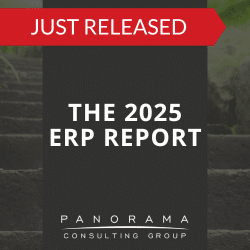Are you wondering how to validate an ERP system? ERP system validation is not the only way to prevent ERP failures, but it’s one of the most important.
When organizations suspect their ERP project is in trouble, they often ask us to perform some form of validation. If you suspect the same, here’s an overview of some of the ERP system validation plans, processes, and protocols a third party might conduct to validate your software.
The Importance of an ERP System Validation Plan
If you’re preparing to roll out a new ERP system, you want to ensure it aligns with your specific business processes. These functions will look different for each business, but the key is to confirm that they operate in the right way.
This is where the ERP system validation process comes in.
By the time you’re ready to perform this type of testing, you should have confirmed that the system meets your compliance and business process needs. Thus, the ERP system validation stage isn’t about validating the software itself.
Instead, it includes steps to ensure the overall solution has been set up and installed as intended. The key questions to ask include:
• Have you configured the system to perform the company-documented and industry-regulated processes your business must perform?
• Does the system operate as intended?
• Are there procedural controls in place for system use?
• Have all employees been trained on how to use the system?
In certain sectors, business leaders are legally required to confirm that certain processes are verified in the ERP system. In addition to an internal audit of documented processes, the validation stage will also include verification by a third party to ensure accuracy and compliance
A Failed Payroll System Implementation
Panorama’s Expert Witness team was retained to provide a forensic analysis and written report to the court regarding the failed implementation of a major software developer’s ERP/payroll system.
10 Steps in ERP System Validation
Now that we’ve covered the meaning of ERP system validation why the process is so important, let’s take a closer look at how ERP validation works. Here are the steps that are typically included in this stage of the ERP software validation plan, including the important documentation and protocol that each one requires.
1. Define User Requirements
Before you can validate that your ERP system is set up correctly, you need to define what you expect it to do. A user requirements document outlines the functionality that your business requires.
Ideally, you should create this document before the ERP software selection process. That way, you can make sure the solution you choose is well-suited for your operations.
2. Create a Validation Project Plan
Next, create a project plan that describes how the validation will go. The key parts to include are:
• Who will perform the validation
• What steps the validation will include
• Where the validation will occur
• When the validation will occur
This is the document you’ll use to describe how the process will take place. Start by explaining the purpose of this stage, as well as any limitations, acceptance criteria, and assumptions that relate to it.
Most companies create a dedicated validation team to perform this process. This team can include any stakeholders you choose, but make sure to account for the following roles:
• Project manager
• Technical lead
• Quality assurance lead
• Validation lead
• Support lead
3. Define Functional Specifications
In some ways, a functional specification document is similar to the user requirements document you created in Step 1. The main difference is that this one contains a greater level of detail.
Instead of describing each function in two to three sentences, you’ll expand it into four or five sentences. The goal is to link what the user needs to what you expect the system to do.
4. Perform a Gap Analysis
When reviewing your functional specifications, do you notice any gaps between what you need the ERP system to do, and what it’s capable of doing? If so, gather these into a gap analysis.
This analysis documents and prioritizes organizational risk based on system deficiencies. For all your high-risk gaps, you should have plans and procedures in place to mitigate those vulnerabilities and optimize team performance.
5. Define Installation Protocol
The installation protocol document describes how the team will implement the ERP system. Typically, your vendor is the one who creates this document. Most protocols include the following components:
• Hardware specifications
• Installation instructions
• Where to document hardware/software verification
6. Create an Installation Report
This report is evidence that the system was installed correctly, following the vendor’s recommendation and design. If your in-house team performs this installation, they’ll keep this documentation for internal review. If your vendor performs the installation, they should provide you with this report.
7. Define Testing Protocol
The ERP system testing process can be complex. A testing protocol document outlines every component included, such as:
- Objectives of system testing
- Specific testing procedures to follow
- Data sets to complete
- Different testing scenarios
- Expected results
- Acceptance criteria
The ERP validation protocols should be designed to test the system and software components your company plans to use. Your software vendor should have already tested the system’s various settings. At this stage, you are simply verifying that the tests were performed.
8. Create a Testing Report
The testing report is the natural outcome of the testing protocols, described above. This is a summary that describes the test execution, with details that include:
• How the team adhered to test procedures
• The acceptability of results
• Any irregular or unexpected results that occurred
9. Define System Release/Go-Live Process
When the ERP system is released, it’s officially ready to be used in production. When you reach this stage, it means that you’ve accomplished the following steps, and end users can begin operating the system:
• User training
• Data migration/entry
• Business scenarios
10. Complete and Maintain System Validation
Once you achieve system validation, it’s important to maintain it throughout the ERP implementation. You can do so by establishing standard operating procedures that describe how you’ll handle system changes and updates, such as:
• Problems and resolutions
• Change requests
• Record retirements
Note that if the validation team deems any changes necessary, they’ll need to authorize, document, test, and approve them before the implementation.
Optimize the ERP System Validation Process
If your team is planning to select an ERP solution, you want to make sure it’s designed to fit your needs now and into the future. An ERP system validation process, plan, and protocol is key to ensuring that solid fit.
While there are many steps involved in the ERP system validation process, it can be smooth and streamlined if you have the right team in place. Our independent ERP consultants can help ensure the end product is functional, feature-rich, and capable of meeting your goals.
To learn more about the services we provide, contact us below.













